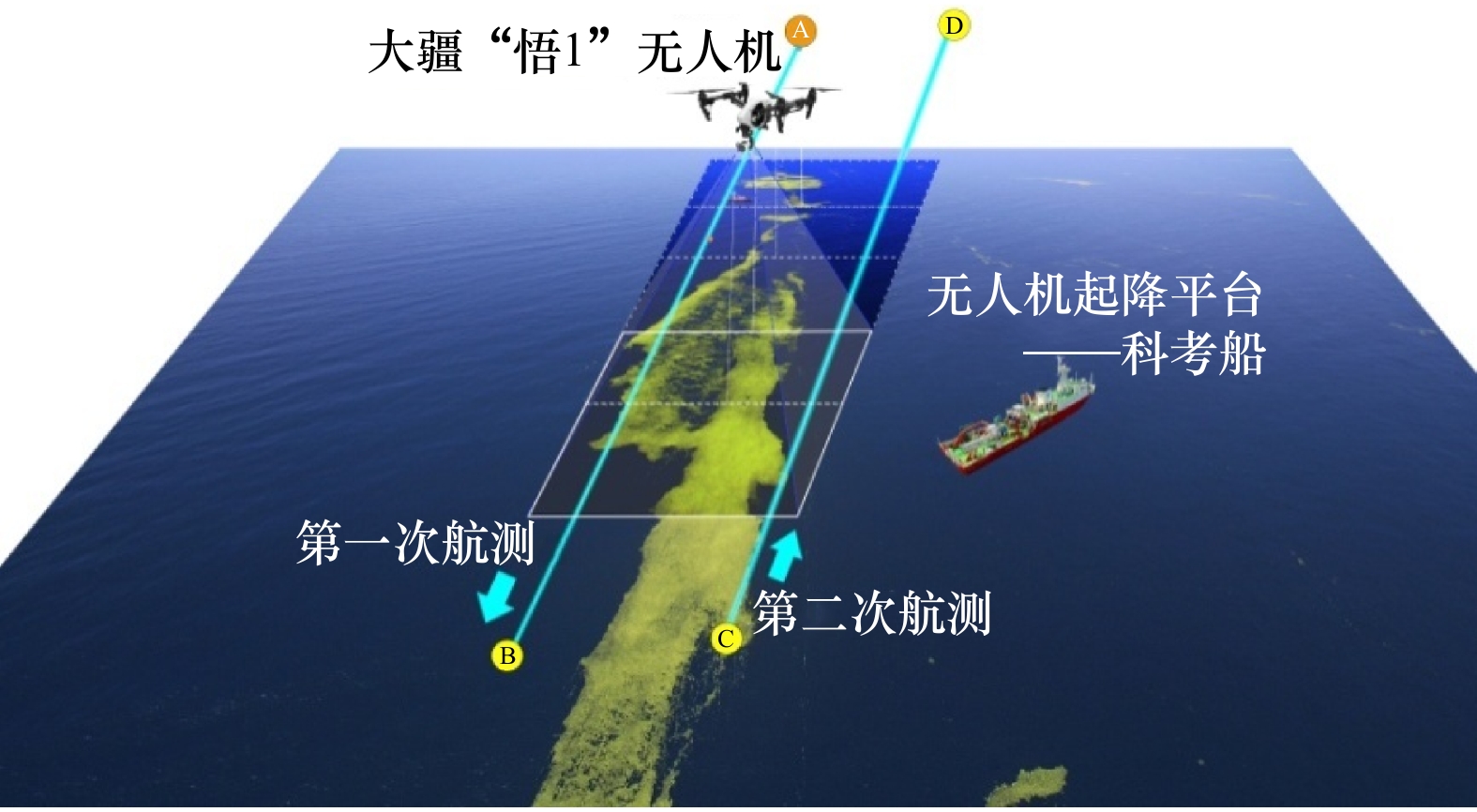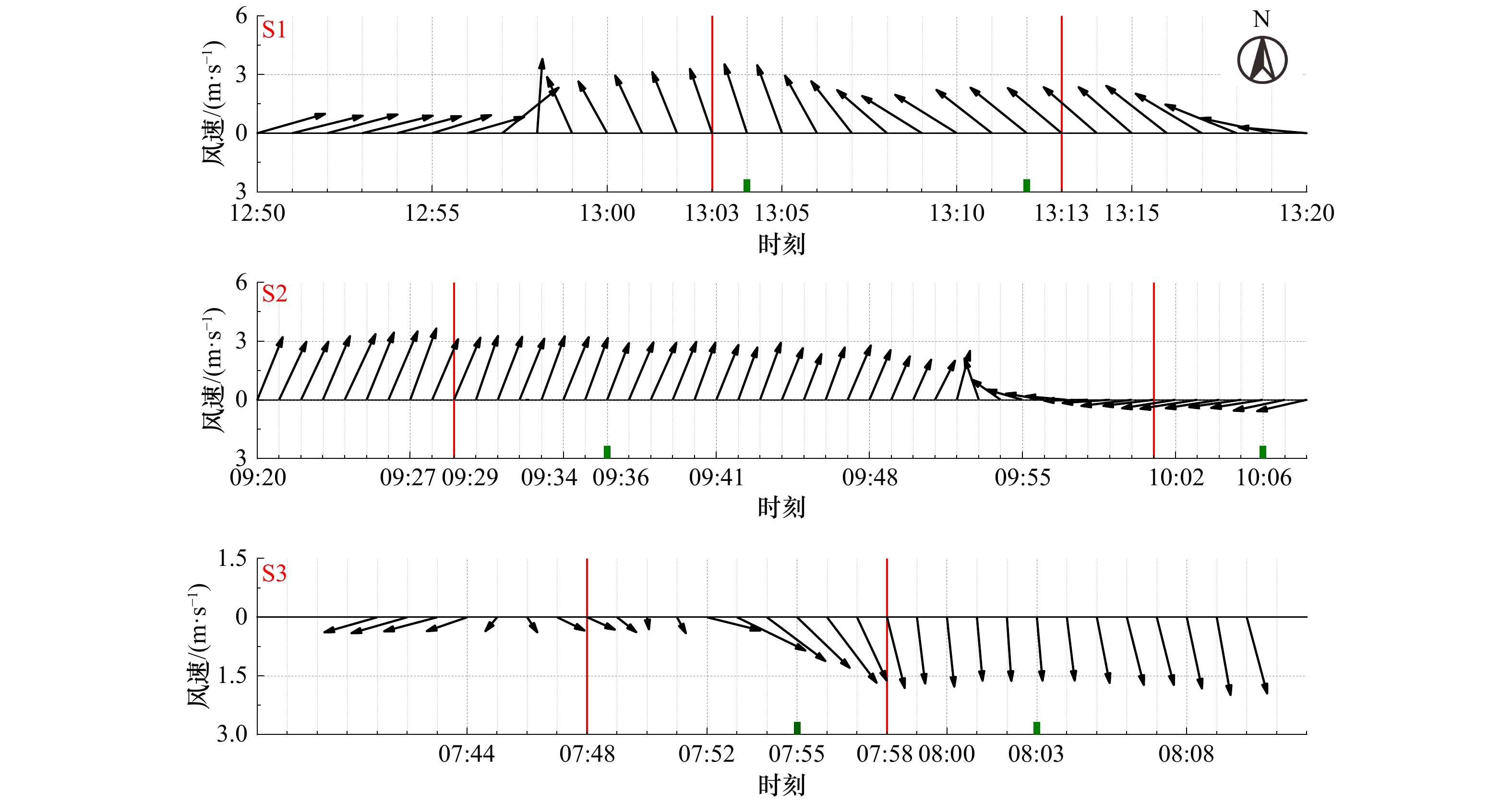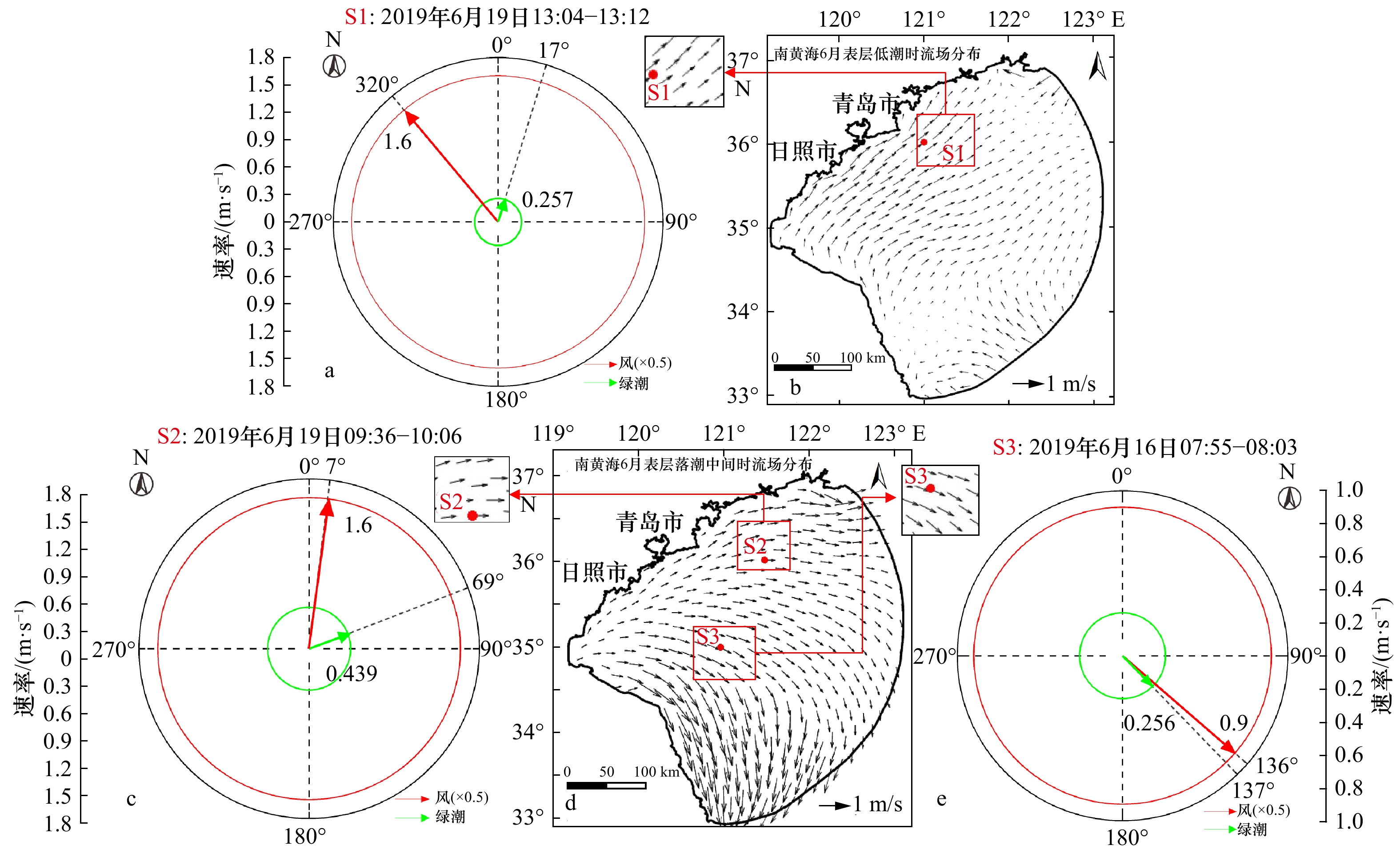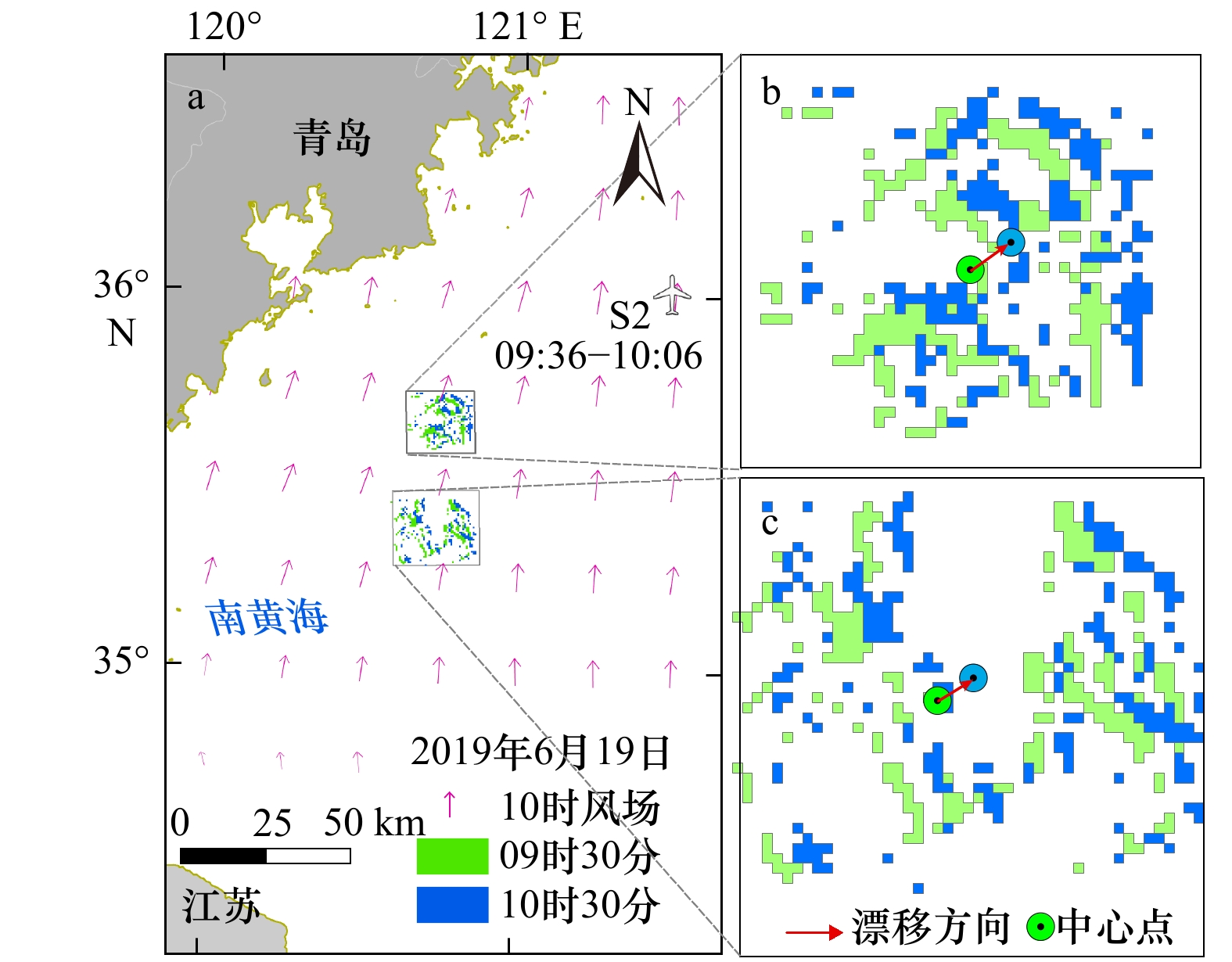Estimation and analysis of the green-tide drift velocity using ship-borne UAV
-
摘要: 无人机遥感具有应用灵活、不受云层干扰以及时空分辨率高的显著优势。为探索无人机在海洋灾害监测中的应用,本文以科考船为起降平台,首次基于无人机获取的双时相绿潮正射影像,开展了黄海绿潮漂移速度的估算研究。同时对比了卫星影像提取的速度结果,并探讨了风与潮流对海上绿潮漂移的驱动。研究发现:(1)可见光波段的漂浮藻类指数能高精度地提取无人机可见光影像中的绿潮(kappa 系数=0.95);(2)无人机遥感估算3个站位的绿潮漂移速率为0.26~0.44 m/s,漂移方向在1天之内变化明显;(3)绿潮短时间内的漂移受到风与潮流的共同影响,漂移方向与M2分潮的潮流方向基本一致,位于风向右侧1°~62°。基于船载的无人机航测,能高精度地估算绿潮漂移速度,为精细化的绿潮灾害预警与防控提供技术支撑。Abstract: Unmanned aerial vehicle (UAV) remote sensing has distinct advantages of flexible use, no cloud interference, and high spatial-temporal resolution. Aim to explore UAV’s utilization potential in marine disaster monitoring, research ship was used as the UAV landing pad, and for the first time, based on the bi-temporal orthophotos acquired by the ship-borne UAV, the drift velocity of green-tide in the Yellow Sea was estimated. In addition, the velocity result extracted from satellite images was compared, and the influences of wind and tidal currents on green-tide drift were analyzed. The results show that: (1) the red-green-blue floating algae index (RGB-FAI) can extract green-tide patches from UAV-based RGB orthophotos with a high-accuracy (kappa coefficient=0.95); (2) the green-tidal speed of three sites estimated by UAV remote sensing are 0.26−0.44 m/s, and the drift direction changed significantly throughout the day; (3) the short-term drift of green-tide is forced by the wind and tidal current. The drift direction of the green-tide is basically consistent with the tidal current of M2, at 1°−62° to the right of wind direction. The ability to estimate green-tidal velocity accurately from the ship-borne UAV images is expected to provide technical support for the precise prediction, warning and control of green-tide disaster.
-
Key words:
- UAV remote sensing /
- Yellow Sea /
- green tides /
- drift velocity /
- RGB-FAI
-
图 7 绿潮、风、潮流的移动矢量图
a、c、e分别为S1、S2、S3站点风与绿潮漂移的矢量图,红色箭头为风矢量,绿色箭头为绿潮漂移矢量;b、d分别为南黄海6月表层低潮时、落潮中间时的流场分布(改绘自文献[29]),红点标识了3个站点的位置
Fig. 7 Motion vector of green-tide, wind and tidal current
a, c, e are vector diagrams of wind and green-tide drift at sites S1, S2 and S3, respectively, with red arrow as the wind vector and green arrow as the green-tide drifting vector; b, d are the tidal current field of the low tide and the middle of ebb in surface of the southern Yellow Sea in June (modified from reference [29]), where the red dots indicate the positions of three sites
表 1 绿潮提取误差矩阵表
Tab. 1 Error matrix of green-tide extraction
海水 绿藻 行总和 用户精度/% 海水 692 17 709 97.60 绿藻 4 286 290 98.62 列总和 696 303 999 生产者精度/% 99.43 94.39 表 2 绿潮斑块漂移速度与风速的统计
Tab. 2 Statistics of green-tide drifting velocity and the corresponding wind velocity
站点 站点坐标 航拍日期 航拍时段 漂移速率/(m·s−1) 漂移方向*/(°) 有效风时段 风速均值/(m·s−1) 风向均值*/(°) S1 36°N, 121°E 2019年6月19日 13:04−13:12 0.257 17.1 13:03−13:13 3.17 139.7 S2 36°N, 121.5°E 2019年6月19日 09:36−10:06 0.439 69.0 09:29−10:01 3.23 186.9 S3 35°N, 121°E 2019年6月16日 07:55−08:03 0.256 136.5 07:48−07:58 1.75 315.7 注:*方向以正北向为0°,顺时针为正。 表 3 基于UAV和GOCI影像的绿潮漂移速度提取结果的对比
Tab. 3 Comparison of green-tide drifting velocity derived from UAV and GOCI images
无人机遥感 GOCI卫星遥感 偏差* 影像分辨率/m 0.14 500 漂移方向(北偏东)/(°) 69.0 58.4 2.9% 漂移速率/(m·s−1) 0.439 0.547 0.108 注:*方向偏差=∣测定值−基准值∣/360°×100%;速率偏差=∣测定值−基准值∣。 -
[1] Liu Dongyan, Keesing J K, He Peimin, et al. The world’s largest macroalgal bloom in the Yellow Sea, China: formation and implications[J]. Estuarine, Coastal and Shelf Science, 2013, 129: 2−10. doi: 10.1016/j.ecss.2013.05.021 [2] 于仁成, 孙松, 颜天, 等. 黄海绿潮研究: 回顾与展望[J]. 海洋与湖沼, 2018, 49(5): 942−949. doi: 10.11693/hyhz20180700158Yu Rencheng, Sun Song, Yan Tian, et al. Progresses and perspectives on green-tide studies in the Yellow Sea[J]. Oceanologia et Limnologia Sinica, 2018, 49(5): 942−949. doi: 10.11693/hyhz20180700158 [3] 于仁成, 刘东艳. 我国近海藻华灾害现状、演变趋势与应对策略[J]. 中国科学院院刊, 2016, 31(10): 1167−1174.Yu Rencheng, Liu Dongyan. Harmful algal blooms in the coastal waters of China: current situation, long-term changes and prevention strategies[J]. Bulletin of the Chinese Academy of Sciences, 2016, 31(10): 1167−1174. [4] Wang Zongling, Xiao Jie, Fan Shiliang, et al. Who made the world's largest green tide in China?—an integrated study on the initiation and early development of the green tide in Yellow Sea: Green tide in Yellow Sea of China[J]. Limnology & Oceanography, 2015, 60(4): 1105−1117. [5] 颜天, 于仁成, 周名江, 等. 黄海海域大规模绿潮成因与应对策略——“鳌山计划”研究进展[J]. 海洋与湖沼, 2018, 49(5): 950−958. doi: 10.11693/hyhz20180700156Yan Tian, Yu Rencheng, Zhou Mingjiang, et al. Mechanism of massive formation and prevention strategy against large-scale green tides in the south Yellow Sea[J]. Oceanologia et Limnologia Sinica, 2018, 49(5): 950−958. doi: 10.11693/hyhz20180700156 [6] 刘材材, 徐韧, 何培民, 等. 南黄海绿潮暴发与紫菜养殖的关系[J]. 海洋科学, 2017, 41(2): 35−43. doi: 10.11759/hykx20141122001Liu Caicai, Xu Ren, He Peimin, et al. Research on the relations between green tide and Porphyra cultivation in the south Yellow Sea[J]. Marine Sciences, 2017, 41(2): 35−43. doi: 10.11759/hykx20141122001 [7] 张清春, 孔凡洲, 颜天, 等. 苏北浅滩养殖筏架附生绿藻入海过程在黄海绿潮形成中的作用[J]. 海洋与湖沼, 2018, 49(5): 1014−1020. doi: 10.11693/hyhz20180400076Zhang Qingchun, Kong Fanzhou, Yan Tian, et al. Green algae detached from aquaculture rafts into seawater resulted in green tide occurrence in the Yellow Sea[J]. Oceanologia et Limnologia Sinica, 2018, 49(5): 1014−1020. doi: 10.11693/hyhz20180400076 [8] Liu Dongyan, Keesing J K, Dong Zhijun, et al. Recurrence of the world’s largest green-tide in 2009 in Yellow Sea, China: Porphyra yezoensis aquaculture rafts confirmed as nursery for macroalgal blooms[J]. Marine Pollution Bulletin, 2010, 60(9): 1423−1432. doi: 10.1016/j.marpolbul.2010.05.015 [9] Bao Min, Guan Weibing, Yang Yang, et al. Drifting trajectories of green algae in the western Yellow Sea during the spring and summer of 2012[J]. Estuarine, Coastal and Shelf Science, 2015, 163: 9−16. doi: 10.1016/j.ecss.2015.02.009 [10] 王宗灵, 傅明珠, 肖洁, 等. 黄海浒苔绿潮研究进展[J]. 海洋学报, 2018, 40(2): 1−13.Wang Zongling, Fu Mingzhu, Xiao Jie, et al. Progress on the study of the Yellow Sea green tides caused by Ulva prolifera[J]. Haiyang Xuebao, 2018, 40(2): 1−13. [11] 衣立, 张苏平, 殷玉齐. 2009年黄海绿潮浒苔爆发与漂移的水文气象环境[J]. 中国海洋大学学报, 2010, 40(10): 15−23.Yi Li, Zhang Suping, Yin Yuqi. Influnce of environmental hydro-meteorological conditions to enteromorpha prolifera blooms in Yellow Sea, 2009[J]. Periodical of Ocean University of China, 2010, 40(10): 15−23. [12] 夏深圳. 基于遥感的黄海浒苔漂移速度与驱动机制研究[D]. 南京: 南京大学, 2016.Xia Shenzhen. Distribution and driving mechanism of the drift velocity of Ulva prolifera in the Yellow Sea based on remote sensing[D]. Nanjing: Nanjing University, 2016. [13] 陈晓英, 张杰, 崔廷伟, 等. 基于高分四号卫星的黄海绿潮漂移速度提取研究[J]. 海洋学报, 2018, 40(1): 29−38.Chen Xiaoying, Zhang Jie, Cui Tingwei, et al. Extraction of the green tide drift velocity in the Yellow Sea based on GF-4[J]. Haiyang Xuebao, 2018, 40(1): 29−38. [14] 钟山, 丁一, 李振, 等. MODIS浒苔遥感监测误差分析研究[J]. 遥感信息, 2013, 28(1): 38−42. doi: 10.3969/j.issn.1000-3177.2013.01.009Zhong Shan, Ding Yi, Li Zhen, et al. Error analysis on enteromorpha prolifera monitoring using MODIS data[J]. Remote Sensing Information, 2013, 28(1): 38−42. doi: 10.3969/j.issn.1000-3177.2013.01.009 [15] 王法景, 盛辉, 苏婧, 等. 基于GOCI数据的绿潮覆盖面积精细化提取方法[J]. 测绘地理信息, 2018, 43(5): 24−27.Wang Fajing, Sheng Hui, Su Jing, et al. Refined extraction method for green tide coverage area based on GOCI data[J]. Journal of Geomatics, 2018, 43(5): 24−27. [16] 李佳琦, 李家国, 朱利, 等. 太原市黑臭水体遥感识别与地面验证[J]. 遥感学报, 2019, 23(4): 773−784.Li Jiaqi, Li Jiaguo, Zhu Li, et al. Remote sensing identification and validation of urban black and odorous water in Taiyuan City[J]. Journal of Remote Seinsing, 2019, 23(4): 773−784. [17] Wang Shengke, Liu Lu, Qu Liang, et al. Accurate Ulva prolifera regions extraction of UAV images with superpixel and CNNs for ocean environment monitoring[J]. Neurocomputing, 2019, 348: 158−168. doi: 10.1016/j.neucom.2018.06.088 [18] Jiang Xiaopeng, Gao Zhiqiang, Zhang Qingchun, et al. Remote sensing methods for biomass estimation of green algae attached to nursery-nets and raft rope[J]. Marine Pollution Bulletin, 2020, 150: 110678. doi: 10.1016/j.marpolbul.2019.110678 [19] Jiang Xiaopeng, Gao Meng, Gao Zhiqiang. A novel index to detect green-tide using UAV-based RGB imagery[J]. Estuarine, Coastal and Shelf Science, 2020, 245: 106943. doi: 10.1016/j.ecss.2020.106943 [20] 魏传杰. 南黄海水文环境季节变化与湍流混合研究[D]. 青岛: 中国科学院海洋研究所, 2018.Wei Chuanjie. Seasonal variability of hydrological properties and turbulent mixing in southern Yellow Sea[D]. Qingdao: Institute of Oceanology, Chinese Academy of Sciences, 2018. [21] 张正龙. 我国黄、东海浒苔和马尾藻的遥感鉴别及绿潮发生过程研究[D]. 上海: 华东师范大学, 2014.Zhang Zhenglong. Remote sensing identification of Ulva prolifra and Sargassum and evolution of green tide in the Yellow Sea and the East China Sea[D]. Shanghai: East China Normal University, 2014. [22] 万剑华, 王朝, 刘善伟, 等. 消费级无人机的大比例尺测图能力分析[J]. 测绘通报, 2018(6): 104−108.Wan Jianhua, Wang Zhao, Liu Shanwei, et al. Analysis of large scale mapping capability of consumer unmanned aerial vehicles[J]. Bulletin of Surveying and Mapping, 2018(6): 104−108. [23] Fairman H S, Brill M H, Hemmendinger H. How the CIE 1931 color-matching functions were derived from Wright-Guild data[J]. Color Research & Application, 1997, 22(1): 11−23. [24] Ryu J H, Han H J, Cho S, et al. Overview of geostationary ocean color imager (GOCI) and GOCI data processing system (GDPS)[J]. Ocean Science Journal, 2012, 47(3): 223−233. doi: 10.1007/s12601-012-0024-4 [25] 蔡晓晴. 基于静止轨道海洋水色卫星数据的绿潮遥感探测方法和逐时变化特征研究[D]. 青岛: 中国海洋大学, 2014.Cai Xiaoqing. Remote sensing detection and diurnal variation research of green macro-algae bloom by geostationary ocean color imager[D]. Qingdao: Ocean University of China, 2014. [26] 宋德彬, 高志强, 徐福祥, 等. 基于GOCI的2017年南黄海浒苔演变遥感分析[J]. 海洋与湖沼, 2018, 49(5): 1068−1074. doi: 10.11693/hyhz20171200330Song Debin, Gao Zhiqiang, Xu Fuxiang, et al. Spatial and temporal variability of the green tide in the south Yellow Sea in 2017 deciphered from the GOCI image[J]. Oceanologia et Limnologia Sinica, 2018, 49(5): 1068−1074. doi: 10.11693/hyhz20171200330 [27] Rosenfield G H, Fitzpatrick-Lins K. A coefficient of agreement as a measure of thematic classification accuracy[J]. Photogrammetric Engineering and Remote Sensing, 1986, 52(2): 223−227. [28] Son Y B, Choi B J, Kim Y H, et al. Tracing floating green algae blooms in the Yellow Sea and the East China Sea using GOCI satellite data and lagrangian transport simulations[J]. Remote Sensing of Environment, 2015, 156: 21−33. doi: 10.1016/j.rse.2014.09.024 [29] 于晓杰. 南黄海西部夏季环流及其对浒苔漂移影响的数值研究[D]. 青岛: 中国海洋大学, 2011.Yu Xiaojie. Numerical study about circulation in summer and its impact on the drift of enteromorpha prolifera in the western part of south Yellow Sea[D]. Qingdao: Ocean Univerisity of China, 2011. -





 下载:
下载:







